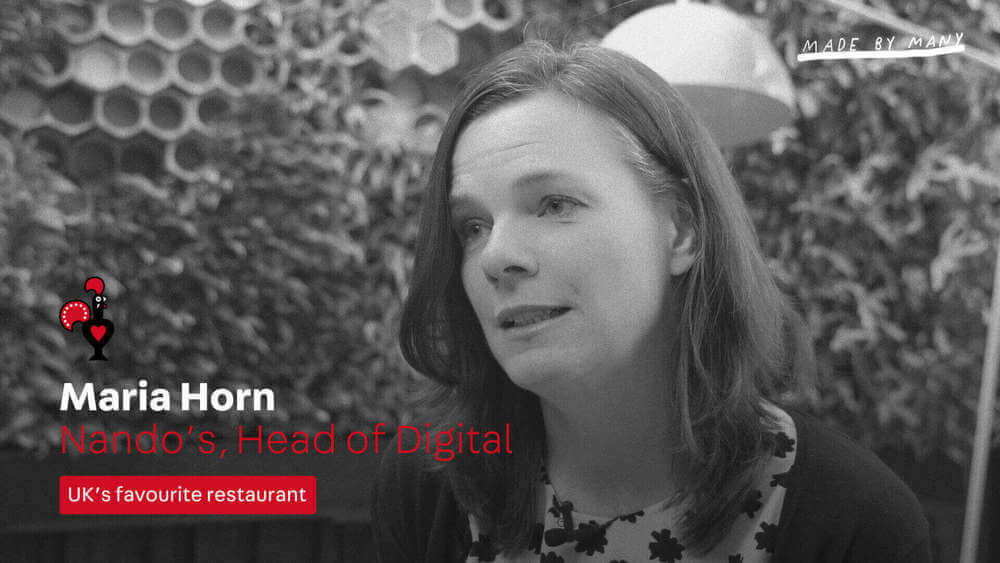Lab rats - true tales of digital innovation

There is no set formula, process or structure for becoming a digital business, but these two case studies suggest that the key to understanding how to organise for innovation lies in a combination of ambition, capabilities and the maturity of the transformation process itself.
In the last five years we have seen an increasing demand for help in establishing dedicated innovation teams (labs, garages, factories…choose your metaphor for making, testing and learning). A constant tension has been the relationship between the lab (let’s call it that) and the core business, a tension between the desire to nurture learning and change and the need to exploit existing assets and to scale. What’s the best way to deal with that dilemma? There’s no one answer, but these two stories of more-or-less failure and success might shed some light.
The ‘Tower’ Project
Made by Many’s first experience of working within a standalone innovation lab was in 2009–10 with a major UK media group. A group of journalists and technologists had escaped the editorial HQ in on one side of central London to a greenfield space high in a skyscraper on the opposite side of town. We’ll call this the Tower Project (not its real name). They had a brief to create digital editorial products with alternative commercial income streams and to establish a more entrepreneurial culture, with the promise of high rewards. In partnership with this team we made a fashion supplement, a glossy digital edition that offered a premium advertising environment and a content-to-commerce retail proposition.
The advertising offer was a resounding commercial success, but ‘Tower’ overall was a failure lasting just a few months; there was misalignment between objectives and rewards, and the team lacked certain kinds of expertise. Our observations — from the inside — at Tower made us firm believers in open innovation, not skunkworks. We saw the negative impact of lofting an elite group into an ivory tower to build a future that the larger, more traditional part of a business could only feel threatened by. Six years later, after multiple failed attempts to confront disruptive digital challengers (including a paywall, since abandoned, then rebuilt) the media group has polished up its in-house digital product and design skills and built better editorial tools and customer interfaces.
But like many news publishers in search of a viable business model, the group has opted for reach and page views over quality of audience or editorial. This raises two questions: did the failure of the Tower project discourage the group from any further exploration beyond the edges of its existing business model? And should the initial focus have been on making radical change to the culture, process and systems of its core business? (And if so, what would have been the best structure to achieve this?)
Why ‘Why?’ matters
We carried out a survey of innovation initiatives and found that innovation labs often lack clear objectives or a shared understanding of what “innovation” actually means or how it relates to a business’s particular circumstance. Often companies indulge in innovation tourism as a knee-jerk but pain-free response to a perceived and most likely real threat. Any business attempting to redefine itself around a digital operating model has, we think, four ways to think about what can be achieved according to the scale of the problem. The objectives can be defined, in order of difficulty and reward, as:
1. Creating new channels to market that improve access to existing products (i.e. physical goods or information goods). This often means resolving a channel, process or organisational dysfunction.
2. Placing new service layers around existing products that can transform the potential of an under-exploited or dormant business asset.
3. In extremis this might involve disrupting an existing market — the very market in which your own business model thrives or survives because of some systemic inefficiency. Whatever you do, do this before someone else does.
4. Founding entirely new and disruptive ventures that create and capture new sources of value. This implies either a “burning platform” (in which case get out of the business) or an insurmountable block on leveraging existing assets.
‘Tower’ was operating somewhere between the first and second category, but using a tactic more appropriate to the early stages of a third (a skunkworks). Our media group might have been better off taking a radical approach to improving both the channels available to customers to access its existing business (news and advertising), and the tools available to produce them. In an established company, the emphasis of innovation should be on the core business if it is perceived to have a future, and if not, the focus will be on an area adjacent to or completely apart from it. This is one of those obvious statements that doesn’t get made very often, in part because few businesses can admit openly that they have no future without life-threatening surgery.
VRT
The second case study is Flemish public service broadcaster Vlaamse Radio- en Televisieomroeporganisatie (Belgium’s nearest equivalent to the BBC). The VRT case demonstrates the importance of the relationship between an objective and the approach that is taken to achieve it. Because it understood that relationship, VRT established three distinct innovation models serving three different business objectives.
In 2013 VRT’s business problem was of the “burning platform” category. Certain TV and radio categories in news, information and entertainment were losing entire audiences to Facebook, YouTube and BitTorrent. The 16–24 year-olds were soon followed by pretty much anyone under 40. With a public service remit to foster Flemish language and culture, VRT had to make a radical change to re-engage its lost audience. The question was how?
The bare bones of a strategy were built around the cataclysmic assumption that the value of most of VRT’s existing broadcast production and brand assets was nil or negative: there was no apparent appetite within the traditional VRT TV news organisation for change; and yet the news habits of young people were changing so profoundly that a broadcast mentality would get in the way of producing the kind of content and services that would strike a chord with them.
We helped VRT set up two innovation initiatives. The first, VRT Start-up, began as a group of a dozen people drawn from existing news, sport and digital teams as well as recruits with new skills. Start-up had an explicit brief to learn and adopt new techniques such as qualitative research, ideation, rapid prototyping and testing, smoke tests in the market and early launch of promising ideas. All this was in pursuit of a wider goal of identifying promising product ideas quickly, but also understanding the business impact of a Lean approach on a traditional organisation. What sort of organisation and investment process would it take to scale and sustain digital information products?
The second initiative was Open VRT, a programme of public events in major Flemish cities to identify young talent, the people who were already making popular digital content but lacked the business skills or finance to succeed in the longer term. Open VRT was founded on the assumption that these vital new skills did not exist in-house at VRT.
How was this different to the Tower model? In three important ways.
First, although VRT Start-up was separate from existing departments, programmes or channel brands, a great deal of effort was invested in involving and communicating with the broadcast organisation. In the set-up phase a self-selecting group of producers, editors, channel controllers and technologists contributed to the strategy and there was direct involvement by the board. We held workshops with up to 100 people at a time to introduce new development techniques and generate product ideas. Individuals with talent and interest in digital media were seconded to the team. The broader group was integral to the success of the project and welcomed new product ideas from Start-up into their own parts of the organisation when the time became right.
The second difference was the introduction of a new culture of work and decision-making. Broadcast TV spends a fortune on audience research and many months in creating and testing pilots at a very large scale — but what gets to this stage is based on personal editorial judgement. We had to squeeze down the time and money by a factor of 10, multiply the number of concepts tested and replace speculation with evidence. Technology was bootstrapped, not deeply integrated or outsourced. Prototypes were strung together in days, not weeks; some of these tested content, others tested means of delivery, brand concepts, production tools — never all at once because that causes waste and clouds results (this didn’t all happen smoothly by the way; some of it was learnt by trial and error). Customer-focus, collective design, never building more than you need to, light integration, lots of small experiments validated by testing, always making continuous improvements: these ideas were brought together as a broad philosophy that infected a small but significant section of an organisation of 2,500 people.
The third difference was recognising the need for new talent. Businesses moving from a hierarchical, managerially controlled model in a well-established sector with decades of learning behind them (in other words, most businesses) tend to deny the discovery that they don’t perform well in a networked and socially- driven world. VRT was happy to acknowledge this and within the framework of VRT Start-up and Open VRT, invested in new talent rather than making the innovation group the bolthole for the bored, incompetent or discontented (this happens: don’t let it). VRT Start-up recruited digital designers, engineers and product managers and brought them together with content producers, social media managers, editors, writers, artists and video makers to create a new nexus of digital production talent to replace the old one built around broadcast film, photography and electrical engineering. This was not easy! It took many months to discover the right kind of people and experience necessary.
New strategies as an emergent property of innovation
As this work developed over time it became possible to see VRT as more of a facilitator, an incubator, a convener of ideas than as a conventional broadcaster. This has been an important emergent property of the process of innovation within the group and was never an explicit objective. The expected success was a big new audience proposition of the kind that would galvanize the organisation around new goals; this was not initially achieved. Instead, in a way that nobody anticipated, Open VRT has given new credibility to the VRT brand within the young, creative community in Flanders.
The success of VRT Start-up hinted that a strategic approach for a major national broadcaster was to plug directly into a new social and economic model where it fills the cultural gaps left by the mainly US-dominated social media sector, facilitating the creation of open, social infrastructure for education, careers, politics, sport, local communities and big national events; and not necessarily through direct provision but by setting up the infrastructure or offering bandwidth, expertise and resources.
This — or any other — big strategy is an impossibility without leadership and finance, the sources of which would have to be the VRT board and the Flemish parliament, respectively. What began as VRT Start-up now has some 100 people. A strong digital operational centre has been established and is split into three teams each with a different purpose: Start-up brings new digital products to early market stage; the Lab answers urgent business questions in a Lean Agile manner; and Studio helps the smarter, younger TV and radio channels to scale and enhance existing products.
There remains the big unanswered question about the existing 95 per cent of the VRT’s operations that are analogue and how a full-scale transition to digital can ever happen. With a nationalist Flemish government, hostage to media barons and hostile to any incursion into areas that might be considered to be the commercial market, it seems unlikely that either the leadership or funds will be forthcoming.
Starting small, with an experiment, is a good policy because it allows strategy to emerge from a set of unknown conditions, rather than be imposed speculatively. But here lies the problem: small must become big if a real transformation is to happen. The size of the innovation budget should be commensurate with the scale of the problem and must adjust according to the demands of the opportunity that is discovered — hence the vital importance of the quality of imagination and communication by the experimenters, so that they can persuade their board and shareholders to invest in radical (they will be) solutions. If a truly ambitious team isn’t connected directly to the Board it will fail.
Best of all, encourage direct participation in the work by senior management. If a board is investing in innovation then the sponsors need to get their hands dirty, not delegate as they would in more familiar areas of business change.
Innovation: a process without a formula
This brings us to one of the biggest challenges facing innovation teams: there is no simple formula for getting it right. In-house is not wrong, so long as the right skills are present, whether they come from owned expertise or agencies/consulting companies (VRT demonstrated this). Acquiring or investing in start-ups isn’t wrong either, so long as you have a good investment process and can provide the acceleration or incubation support necessary — neither of which are as easy as they might sound.
The bottom line
A lab/garage/factory in isolation will fail unless its objectives are entirely peripheral to the business. Where the lab is tied to the fortunes of the core, while it might start as a series of experiments or be used to incubate a learning culture, it must at the earliest responsible stage be tied to the core business at multiple levels but especially through leadership at board level. The budgeting cycle, procurement and investment process and KPIs are all critical factors in success or failure: the investment should reflect the scale of the problem and business opportunity and should be constantly under review as you learn, with a more frequent investment decision cycle based on meeting agreed targets; more like a VC than a conventional annual financial review. Ultimately the “Lab” — by definition a place for experiment — needs to build momentum through multiple cycles of discovery, making and testing to create a continuous pipeline of new product ideas that in and of itself becomes “business as usual”.
Continue reading
What's it like working with Made by Many?
It’s a question lots of people ask - we are different to other consultancies after all.
Full-stack Ruby on Rails Developer (Full-time/Part-time)
We’re looking for a versatile and collaborative full-stack software developer to join our team.
Full-stack Software Developer (Full-time)
We’re looking for an experienced and versatile developer who enjoys building great products and working collaboratively in cross-disciplinary teams.


